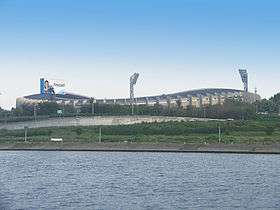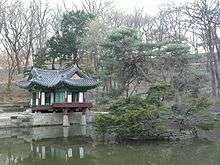Climate of Seoul
Coordinates: 37°34′08″N 126°58′36″E / 37.56889°N 126.97667°E
The climate of Seoul features a humid continental/subtropical climate with dry winter, called "Dwa"/"Cwa", see (Köppen climate classification). Seoul is classed as having a temperate climate with four distinct seasons, but temperature differences between the hottest part of summer and the depths of winter are extreme. In summer the influence of the North Pacific high-pressure system brings hot, humid weather with temperatures soaring as high as 35 °C (95 °F) on occasion. In winter the city is topographically influenced by expanding Siberian High-pressure zones and prevailing west winds, temperatures dropping as low as -20 °C (-4 °F). The bitterly cold days tend to come in three-day cycles regulated by rising and falling pressure systems, during winter snowfall can cause frosty weather in the city. The most pleasant seasons, for most people in the city are spring and autumn, when azure blue skies and comfortable temperatures are a sure bet. Most of Seoul's precipitation falls in the summer monsoon period between June and September, as a part of East Asian monsoon season.[1]
| Climate data for Seoul (normals 1981–2010, extremes 1913–present) | |||||||||||||
|---|---|---|---|---|---|---|---|---|---|---|---|---|---|
| Month | Jan | Feb | Mar | Apr | May | Jun | Jul | Aug | Sep | Oct | Nov | Dec | Year |
| Record high °C (°F) | 14.4 (57.9) |
18.7 (65.7) |
23.8 (74.8) |
29.8 (85.6) |
34.4 (93.9) |
37.2 (99) |
38.4 (101.1) |
38.2 (100.8) |
35.1 (95.2) |
30.1 (86.2) |
25.9 (78.6) |
17.7 (63.9) |
38.4 (101.1) |
| Average high °C (°F) | 1.5 (34.7) |
4.7 (40.5) |
10.4 (50.7) |
17.8 (64) |
23.0 (73.4) |
27.1 (80.8) |
28.6 (83.5) |
29.6 (85.3) |
25.8 (78.4) |
19.8 (67.6) |
11.6 (52.9) |
4.3 (39.7) |
17.0 (62.6) |
| Daily mean °C (°F) | −2.4 (27.7) |
0.4 (32.7) |
5.7 (42.3) |
12.5 (54.5) |
17.8 (64) |
22.2 (72) |
24.9 (76.8) |
25.7 (78.3) |
21.2 (70.2) |
14.8 (58.6) |
7.2 (45) |
0.4 (32.7) |
12.5 (54.5) |
| Average low °C (°F) | −5.9 (21.4) |
−3.4 (25.9) |
1.6 (34.9) |
7.8 (46) |
13.2 (55.8) |
18.2 (64.8) |
21.9 (71.4) |
22.4 (72.3) |
17.2 (63) |
10.3 (50.5) |
3.2 (37.8) |
−3.2 (26.2) |
8.6 (47.5) |
| Record low °C (°F) | −22.5 (−8.5) |
−19.6 (−3.3) |
−14.1 (6.6) |
−4.3 (24.3) |
2.4 (36.3) |
8.8 (47.8) |
12.9 (55.2) |
13.5 (56.3) |
3.2 (37.8) |
−5.1 (22.8) |
−11.9 (10.6) |
−23.1 (−9.6) |
−23.1 (−9.6) |
| Average precipitation mm (inches) | 20.8 (0.819) |
25.0 (0.984) |
47.2 (1.858) |
64.5 (2.539) |
105.9 (4.169) |
133.2 (5.244) |
394.7 (15.539) |
364.2 (14.339) |
169.3 (6.665) |
51.8 (2.039) |
52.5 (2.067) |
21.5 (0.846) |
1,450.5 (57.106) |
| Average precipitation days (≥ 0.1 mm) | 6.5 | 5.8 | 7.4 | 7.8 | 9.0 | 9.9 | 16.3 | 14.6 | 9.1 | 6.3 | 8.7 | 7.4 | 108.8 |
| Average snowy days | 8.0 | 5.2 | 3.4 | 0.1 | 0.0 | 0.0 | 0.0 | 0.0 | 0.0 | 0.1 | 2.1 | 6.1 | 24.9 |
| Average relative humidity (%) | 59.8 | 57.9 | 57.8 | 56.2 | 62.7 | 68.1 | 78.3 | 75.6 | 69.2 | 64.0 | 62.0 | 60.6 | 64.4 |
| Mean monthly sunshine hours | 160.3 | 163.3 | 189.0 | 205.0 | 213.0 | 182.0 | 120.0 | 152.5 | 176.2 | 198.8 | 153.2 | 152.6 | 2,066 |
| Percent possible sunshine | 52.3 | 53.6 | 51.0 | 51.9 | 48.4 | 41.2 | 26.8 | 36.2 | 47.2 | 57.1 | 50.2 | 51.1 | 46.4 |
| Source: Korea Meteorological Administration[2][3][4] (percent sunshine and snowy days)[5] | |||||||||||||
Factors
Seoul has a wet and very humid climate during the summer season, with cold and dry weather during the winter season. Spring (although windy) and autumn are pleasant but are short in duration. These seasons are considered the best time to visit Seoul.[6]
- Siberian winds bring frosty weather with sporadic snowfall in the city, which takes the average temperature down to 0 to -10 degrees Celsius.[6][7]
- Yellow Dust is a seasonal meteorological phenomenon which affects much of East Asia including South Korea sporadically during the springtime months. The dust storms also affect wildlife particularly hard, destroying crops, habitat, and toxic metals interfering with reproduction.[8]
- East Asian monsoon brings heavy precipitation during a short rainy season called jangma, from the end of June through the end of July.
- Typhoon season occurs from July through September. About once each year, a typhoon passes very close to or moves over Korea, causing heavy showers.[8]
Seasonal Climate
Like all temperate climates in the world, Seoul also has four seasons: winter, spring, summer, autumn. The monsoon season and typhoons also occurs in the summer season.[8]
Winter
The winter in Seoul is controlled by the large Siberian high pressure system (the Asiatic high), which results in predominantly cold, dry north-westerly winds. The influence of the Siberian high leads to significantly colder winter temperatures than would be expected at this latitude. About every 4 to 6 days a low-pressure trough will move through South Korea, bringing with it cloudiness and light precipitation. The amount of precipitation locally depends mostly on the elevation of the station and the length of time that the air has been over the Yellow Sea. Maximum snowfall occurs over the northwest coast, which is the most exposed to the northwesterly flow, and in the mountain areas. Normally less than 10 percent of the annual precipitation falls during the winter. Frequently the weather is cloudless, clear, and dry, except for the southwestern region of the peninsula. The mean January temperature in Seoul is -2.4 °C (27 °F). January, is the coldest month in Seoul.
Summer
During the summer, East Asian monsoon winds engulf the city and the warm, moisture laden air moving off the oceans clashes with the drier air to the north. These fronts oscillate back and forth across Korea during the summer months. The interior highlands disturb the winds, forcing them into a westerly/southwesterly direction. The majority of the annual precipitation falls between late June and the middle of September, with rains fully developing along the entire peninsula by mid-June. Seoul receives approximately 126 mm (5 in) of precipitation during the winter (December–March), but in July alone receives approximately 383 mm (14.3 in). July is the wettest month in the metropolis.
Thunderstorms usually occur about 2 to 5 days per month during this period. Summer precipitation in Seoul is as likely to occur at 0200 as at 1400. Humidity is very high and fog will develop whenever a cold air mass confronts this moisture laden air, often forming on cloudless days. The typhoon season occurs from July through September. About once each year, a typhoon will pass very close to or move over Korea, causing heavy showers. Strong winds are usually confined to islands and exposed coastal areas. Although winds might not pose a problem, the associated rainfall can cause significant flash flooding, a very real threat during the rainy season, especially in rough terrain. The mean temperature for Seoul in August is 25.7 °C (78 °F)
Autumn
October is the transition month between the summer rainy season and the cold, dry winter. The predominantly tropical cloudy weather of the summer is replaced by cooler, drier, and less cloudy conditions. The primary weather producers during October are cold frontal systems from the Asian mainland. On the average, one frontal passage per week can be expected during the month. A typical frontal passage is proceeded by increasing middle and high cloudiness with light rain. Following the frontal passage, mostly clear skies can be expected for 3 or 4 days. During this clear period it is very likely for fog to form. Fog is especially prevalent in river valleys and in low-lying areas.
Gallery
See also
References
- ↑ Seoul Weather Forecast, Climate, When to Go: Weather in Seoul Area, South Korea
- ↑ Climate data in seoul, 1981 ~ 2010(Korean), Korea Meteorological Administration.
- ↑ "기후자료 극값(최대값) 전체년도 일최고기온 (℃) 최고순위, 서울(108)". Korea Meteorological Administration. Retrieved 2013-08-18.
- ↑ "기후자료 극값(최대값) 전체년도 일최저기온 (℃) 최고순위, 서울(108)". Korea Meteorological Administration. Retrieved 2013-08-18.
- ↑ "Climatological Normals of Korea" (PDF). Korea Meteorological Administration. 2011. p. 499 and 649. Archived from the original (PDF) on 7 December 2016. Retrieved 8 December 2016.
- 1 2 Korea: General Information about Seoul
- ↑ Fray Adventures: Siberian Winds Ahhh!
- 1 2 3 DPRK Climate







